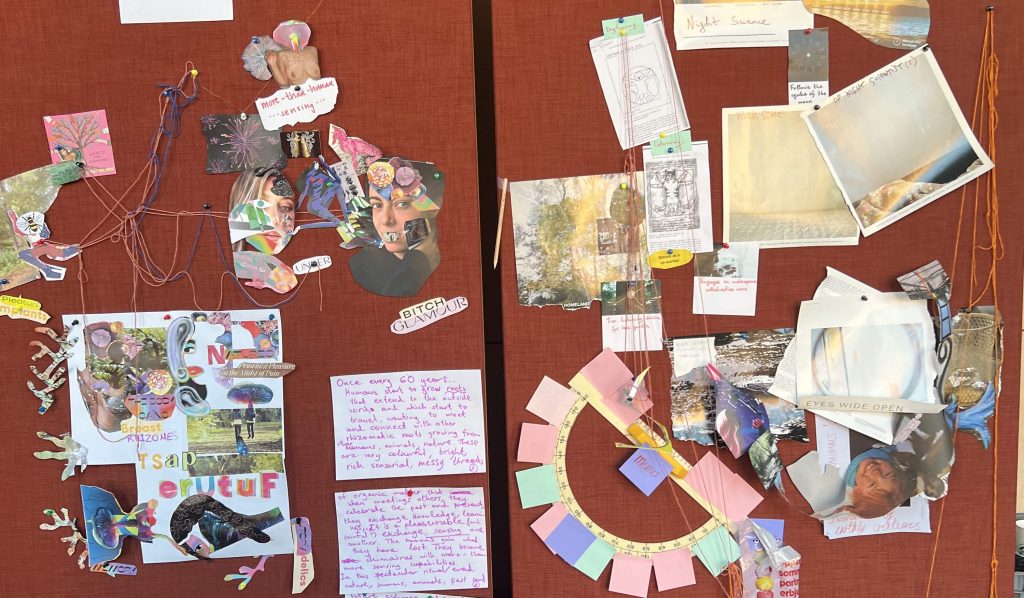
A few days after the kick-off of the “Nordic Fabulation Network” in Umeå, we continued our fabulations some 800 kilometres south, in another Swedish city with a beautiful river running through it: Norrköping. On June 12th, we facilitated a one-day workshop at Nordes, the Nordic Design Research Conference. The workshop was titled “Fabulating Futures for Flourishing and Vibrant Worlds” and co-organized by the organizers of the Nordic Fabulation Network in collaboration with some of the core members of this network. More than 20 participants joined our workshop. This is how we advertised our workshop:
“This one-day workshop will explore fabulations in design research. Bringing together design researchers and practitioners in hands-on exploration and critical dialogue, we will explore emerging practices and potentials of using fabulations in futures-oriented and exploratory practice-based design research. Drawing on fabulations’ relations with feminist technoscience and more-than-human concerns, we seek to understand if and how the practice of fabulating can contribute to designing vibrant worlds that can flourish in new ways.”
Our intention with this workshop was to further inquiry into fabulations within the Nordic design research community, which is a community that has already shown interest in and demonstrated uses of fabulations, for instance in the work by researchers Åsa Ståhl, Kristina Lindström and Li Jönsson. We did not know that our two workshops – in Umeå and Norrköbing – would be directly following each other, however this close timing of the two workshops allowed us to reiterate activities we did in Umeå and deepen our research into fabulation as an approach for designing futures of care.
Our Nordes workshop featured two main activities: 1) a forum session of sharing fabulations or futures that can be manifested through design, and 2) a fabulating session of making fabulations through collage-making and storytelling. Before the forum session began, we presented our Nordic Fabulation Network, and proposed a definition of fabulation in design: as open-ended, having a feminist commitment, and expressing more-than-human concerns. We then started the forum session. We decided to do the forum sharing session in plenum, because we learnt from the Umeå workshop, that collective sharing of and listening to stories is a fantastic way of bringing people together and creating a shared understanding and vocabulary of what stories/values/identities/concerns participants bring to the room. Participants brought a mix of stories to this session; from research anecdotes, to texts they were inspired by (fiction and/or academic), to objects and non-humans, and deeply personal stories. These includes nail polish and rivers and planets, stories of grief and hope, stories that challenge the hero story, swords and carrier bags, semi-biographical stories, anticipatory ethnography, what-if’s, AI-generated stories, cultural histories, maps lots of maps, stories of well-being and sciences (both the fictional and the factual), and all kin(d)s of animals; turtles, rabbits, sheeps, crows. The stories were told and shown through various dialects, accents, oral and bodily languages, and there was a deep attention to each story, as we started to build upon and create references across them.
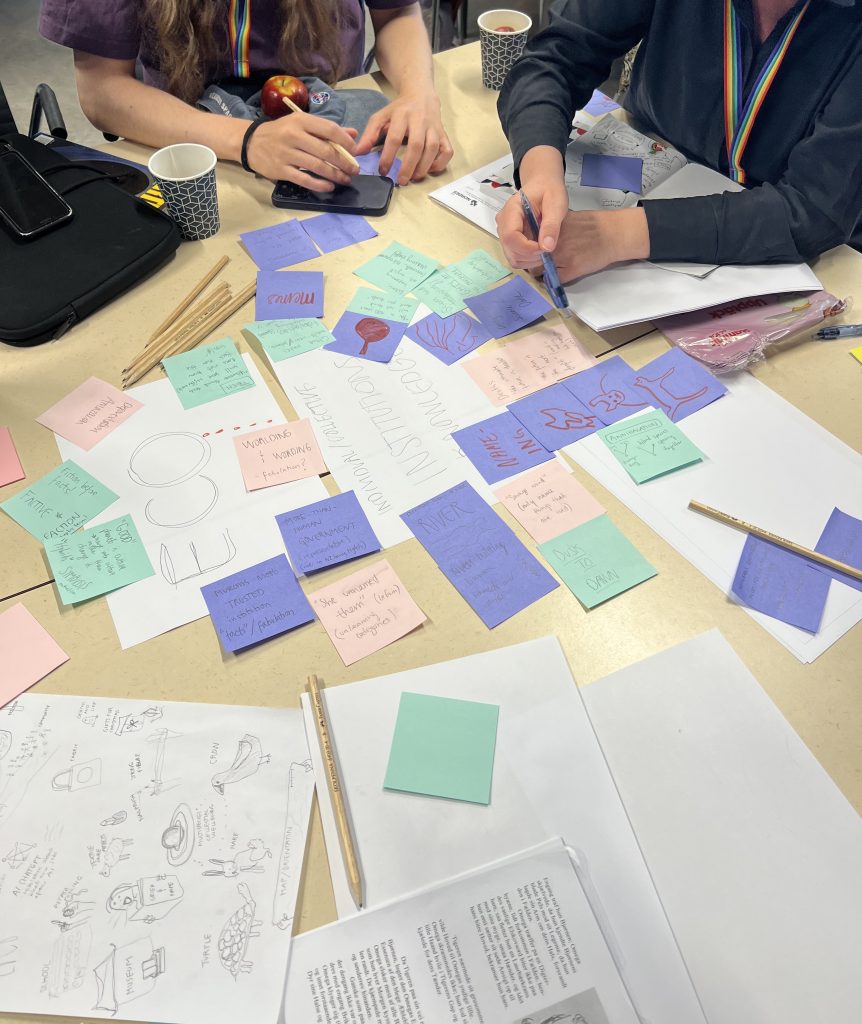
With all these stories in the air, we went into a collective mapping of the stories, opening up to discussing how the stories relate to one’s own research, designs, and personal lived experience. We learnt from the Umeå workshop, that it is important to take time to talk about and relate to all the stories that are shared, rather than quickly move on to a new activity. So we roughly created five topic areas where participants could self-assign to discuss the shared stories further: more-than-human, collective knowledge (institutional versus community), maps/blank-spaces, AI futures, and sensing and memories. We put some groups together and ended up with three groups: 1) the more-than-human collective knowledge group, 2) the AI futures group, and 3) the sensing & memories + maps group. Each group mapped out on a sheet of paper what had resonated with them from the first forum sharing session; and how it related to the topic of the group.
After a lunch break, we moved into the second activity: the fabulating session. We mostly stayed in the same groups as the morning session, and could use the discussions from before lunch to start fabulating. The aim of the session was to fabulate a vibrant and flourishing future, and we gave participants some prompts to start the fabulation:
- Amplify a positive present or think of an alternative to a grand/dominant narrative
- Reconsider who is included or at the center of your story. Challenge the hero story
- How does your story intersect social, cultural, environmental dimensions?
We had brought a lot of image-material for making collages, and participants had also brought their own collage-material of images that inspired them. With a starting point in the image-material, stories, fabulations, lived experience, research and concepts, the three groups started fabulating. We had three pin boards, where groups slowly started creating collages. We tore out pages from magazines, cut out images that could be combined with other images, placed it together on the pin board, added some tape, some thread, suddenly some collages expanded down on the floor and out in the room, attaching itself to chairs and tables meters away. As organizers we participated in a group each, but the fabulating session was mostly self-organized and participants were free to explore in their own directions. For one hour the group created their collages and wrote down stories, and then, as the final part of the workshop, we presented for each other.
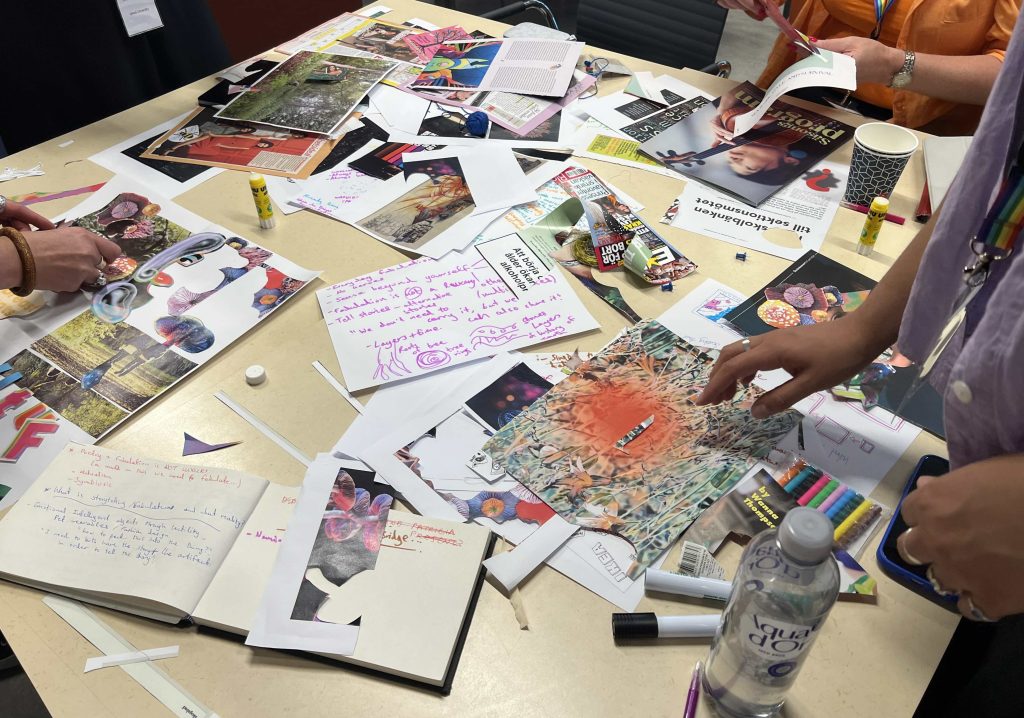
The first group, on more-than-human collective knowledge, was inspired by how more-than-humans participate in science and knowledge making practices such as in institutions like universities and museums. This group created a fabulation about the “Night Scientist”; a science that is inspired by intuition and imaginaries and planned after the moon cycles, a scientist that uses tools such as the tree listening device and frameworks of catology and dogaxonomy. The group’s collage was spread on the board and the surrounding chairs, and in addition to the collage, the group wrote two stories about the Night Scientist using a creative writing method inspired by “exquisite corpse”, where the story was collectively written through one participant writing a section followed by another followed by another etc.
The second group, on AI futures, decided to refocus their fabulating on the relation between and journey of birth and death. This group’s fabulation was inspired by one of the participant’s own lived experience of a loved one passing away, and it celebrated both the birth and death of humans, and discussed ethical and moral questions related to assisted death. The group’s collage flowed freely from the top of the pin board, depicting birth through the womb, and slowly further down to the bottom of the pin board, where the corder represented death. Rather than writing down their story, the group members took turns in performing the story on the spot.
The third, and last group, on sensing, movement and memories, focused their fabulation on a fantastic otherworldly bodily phenomenon where roots grew out of human breasts. This fabulation was inspired both from the root network of trees as well as the milk ducts in human breasts, and the fabulation touched upon how communications between communities of breast roots would play out. The group created a fascinating visual collage strongly representing the fleshy, otherworldly, nature relations that these bodies become with.
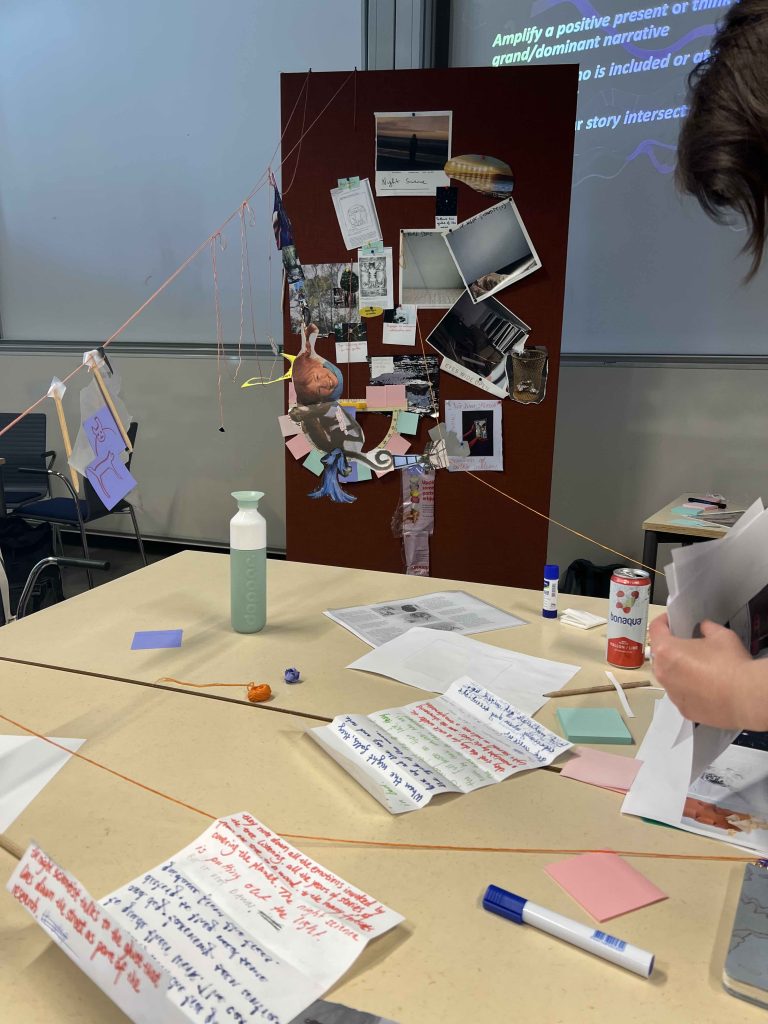
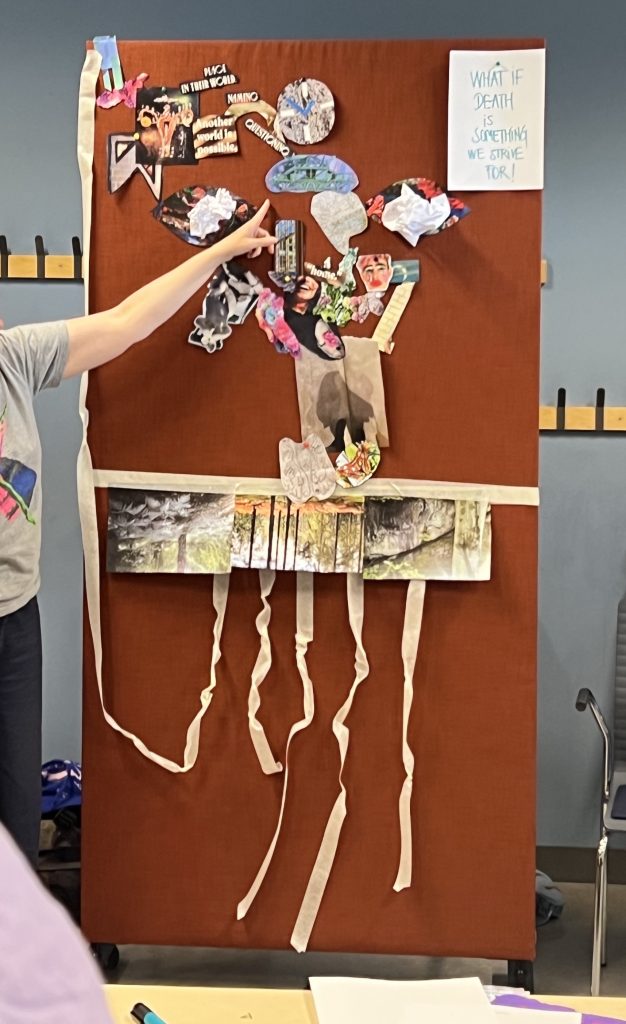

Following the round of presentations, we summarized and discussed the workshop and the potential of fabulation in design research. A conversation arose around the tension and relation between the mundane and spectacular which both design and fabulation share; as storytelling/world-making activities driven towards future change. One participant indeed said that one of the key characteristics and great potentials of fabulation is the strong focus on imagination and wild and weird possibilities; and that we had not been speculative enough in the workshop – we could have gone even wilder! Another conversation became about the question of “what next” or “so what?”; questioning what the purpose of these stories are, what they can bring, and what would be the next step after making the collages and stories. One opinion was that the stories can exist as they are; as designers we don’t always need to turn our exploratory practices into products or final solutions. Another opinion was that after this initial open-ended activity, it would make sense to zoom further in and go from this broader world-making activity to choose one single aspect of the story that could be further explored through design. This could include tangible making practices, for instance making an object or artefact, or it could involve more performative somatic exploration, where the body is brought more into the process through which practices and movements could be further explored.
We will take these and more reflections into our continued work in the Nordic Fabulation Network, and they will be directly useful for our planning of the Oslo workshop later this year. We want to thank all the participants in our workshop, for sharing their stories and their willingness to fabulate with us! We appreciate how the workshop bleeded into the following conference days; as we were able to exhibit the collages in the hallway of the conference venue, and we had many follow-up conversations with participants about the potentials, and potential risks, around fabulation.
Fabulations were further shared at Nordes, and we want to highlight just a few encounters we had. In the paper presentation by Jennie Schaeffer on “Ecocritical experimentation with object theatre at a museum”, non-human voices participate in narrating stories at museums. In the research project “Sorg and Hopp i Omställning – En Orienteringsguide”, by Kristina Lindström, Li Jönsson, Christina Lindqvist, Jonas Larsen, and Per-Anders Hillgren, fictional maps are used to reorient and reimagine alternative paths and futures in the transition to a fossil free society. The presentation of “Destabilizing the quotidian: Urban recipes for cultivating care in the more-than-human city” by Yuxi Liu and Seda Özçetin demonstrated joyful imaginary ways of engaging with non-humans in cities, and the presentation. The presentation of “Generous Crowdedness: Cultivating Space(s) for Care at Alternative Design Museums” by Anja Neidhardt-Mokoena and Healther Wiltse showed the importance of counter stories from protest archives to challenge the dominant canon of design museums. Lastly, the presentation by Joe Lindley et al. on “Ways of seeing design research: A polyphonic speculation” supports our attention to speculation in design research.